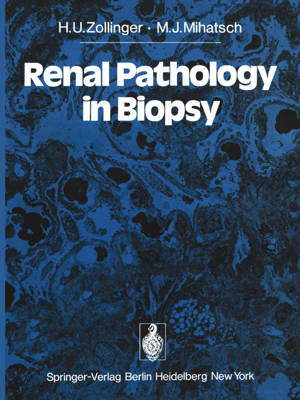
- Afhalen na 1 uur in een winkel met voorraad
- Gratis thuislevering in België vanaf € 30
- Ruim aanbod met 7 miljoen producten
- Afhalen na 1 uur in een winkel met voorraad
- Gratis thuislevering in België vanaf € 30
- Ruim aanbod met 7 miljoen producten
Zoeken
Renal Pathology in Biopsy
Light, Electron and Immunofluorescent Microscopy and Clinical Aspects
H U Zollinger, M J Mihatsch
Paperback | Engels
€ 206,95
+ 413 punten
Omschrijving
Vor die Therapie setzten die Gotter die Diagnose. Otto NiigeJi Renal biopsy has decisively enriched renal diagnostics. Kidney diseases may be monitored during their entire course, and new techniques - such as immunofluorescence and electron microscopy - may be systematically applied, resulting in novel insights into the morphogenesis, pathogenesis, and etiology of kidney lesions. These insights, in turn, have served as new starting points, in the spirit of the quotation above, for the institution of causal therapy by the clinician. This work presents our findings based on 20 years of experience in evaluating renal biopsies. As of the end of 1974, our computer-supported, systematic clinical, morphologic, and follow-up evaluation of case material consisted of over 2000 biopsies, including 679 examined by electron microscopy and 400 by immunofluorescence microscopy. The subsequent 500 biopsies (400 studied by electron microscopy and 300 by immunofluorescence) were con- sidered qualitatively only. In order to enhance qualitative findings with quantitative data, it was necessary to devise new methods for quantifying electron-microscopic findings. Additionally, we attempted to correlate cyto- logic and immunofluorescent observations to integrate the isolated findings of electron microscopy into a vital cytologic pattern of reactions. We also attempted to evaluate the almost overwhelming flood of publications, especially those appearing within the last 10 years. The idea for this book was conceived a decade ago. At that time, however, our own experience in renal biopsy diagnostics seemed insufficient to sup- port such a major undertaking.
Specificaties
Betrokkenen
- Auteur(s):
- Vertaler(s):
- Uitgeverij:
Inhoud
- Aantal bladzijden:
- 688
- Taal:
- Engels
Eigenschappen
- Productcode (EAN):
- 9783642667336
- Verschijningsdatum:
- 17/11/2011
- Uitvoering:
- Paperback
- Formaat:
- Trade paperback (VS)
- Afmetingen:
- 210 mm x 279 mm
- Gewicht:
- 1564 g

Alleen bij Standaard Boekhandel
+ 413 punten op je klantenkaart van Standaard Boekhandel
Beoordelingen
We publiceren alleen reviews die voldoen aan de voorwaarden voor reviews. Bekijk onze voorwaarden voor reviews.








